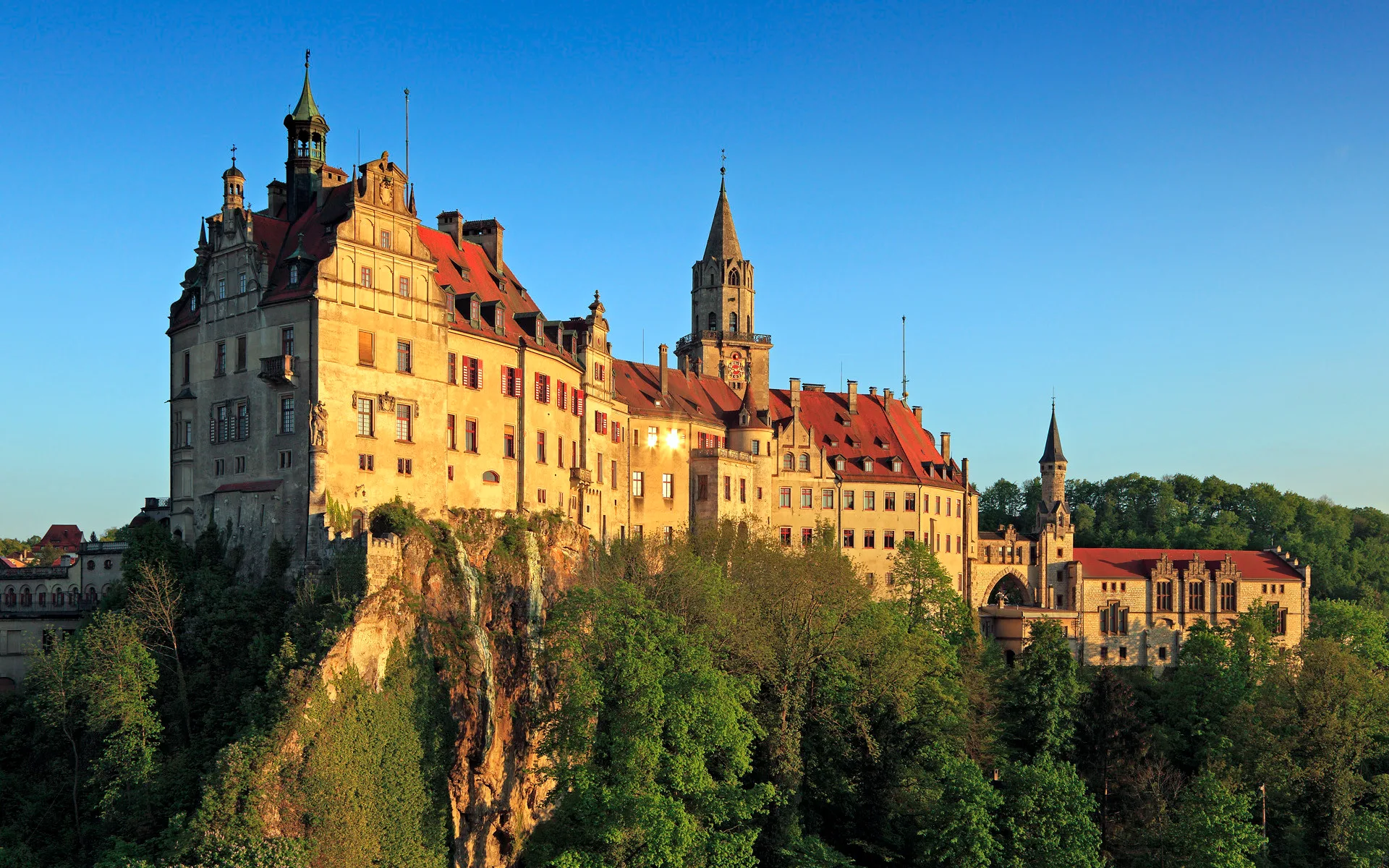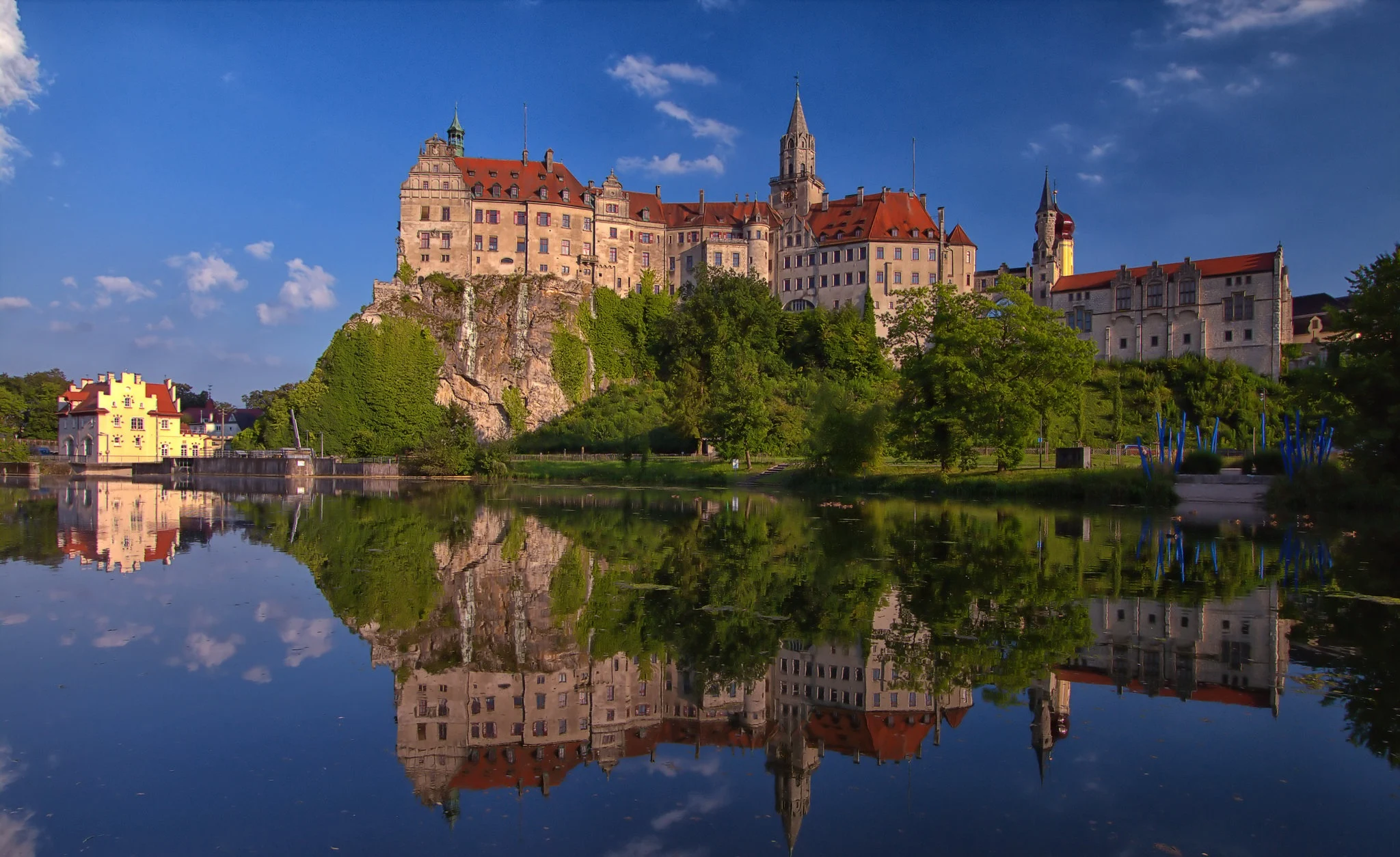The Castle Sigmaringen (Schloss Sigmaringen), the former main royal residence of the State of Hohenzollern-Sigmaringen, is located in the Swabian Alps, Baden-Württemberg (Germany), on a hill picturesque in the city of the same name.
Although the history of the founding of Sigmaringen Castle dates back to the Middle Ages, the current medieval fortress only conserves a few original towers, since in 1893 it was completely rebuilt after a fire. Today, in this former home of the Swabian branch of the Hohenzollern royal family, you can find several interesting museums that, together with majestic architecture, attract thousands of tourists a year.
 |
| Sigmaringen Castle Germany |
The castle's ornate interiors, along with lavish displays of antiques such as exquisite furniture, German porcelain, and unique tapestries, catch the eye of visitors. The walls of Sigmaringen are decorated with works of master painters and its rooms are decorated with beautiful sculptures and statuettes. The castle and its museums are available to be visited throughout the year, but only on excursions with prior reservation.
History of Sigmaringen Castle
For the first time in history, Sigmaringen Castle is mentioned in the chronicles of the Peterhausen monastery, dated 1077. Probably the construction of the castle would have been long before that year, but to try to solve this unknown, detailed archaeological excavations would be required, which are excluded due to the presence of private real estate in the area. If we compare the historical finds from the time of the Roman Empire made around Sigmaringen with the name of the main tower of the castle, from the 12th-20th century, known as the «Roman Tower», it can be said with a certain conviction that the history of this place started quite a few centuries before.
 |
| Sigmaringen Castle Germany |
Information on events associated with the castle during the High Middle Ages is also quite confusing. It is known that in 1077 there was a long siege to the castle of Sigmaringen in which the emperor Henry IV of the Holy Roman Empire was involved. Then there are references to the Mangolde brothers and Ludwig Sigmaringen. In a record dating from the year 1083, it is stated that Ludwig Sigmaringen was married to the daughter of Baron Berthold von Tseringen. At the end of the 11th century, Tseringen founded the Spitzenberg castle in Küchen, which, together with the surrounding lands, was inherited by Ludwig Sigmaringen. Ludwig's sons were credited with founding the Monastery of St. George in the 11th century.
About the life of Sigmaringen it is very difficult to say anything concrete, except the chronology of the possession of the castle. In the period from 1133 to 1170, Sigmaringen was ruled by Ludwig II's son, Rudolf von Sigmaringen-Spitzenberg. Then, starting in 1183, it was his son's. It was with him, in the early 1200s, that the castle was completely built in stone. In 1258, control of the castle passed to Count Ulrich II von Helfenstein-Sigmaringen. In 1272, through the marriage of their daughter, the Sigmaringen family became related to a more eminent family of the Earl of Germany, von Montfort. The owner of the castle was then Ulrich I von Monfort. Later,In 1290, Count Hugo V von Montfort sold the castle and city of Sigmaringen to Rudolf von Habsburg, who in turn did so to the Habsburgs.
 |
| Sigmaringen Castle Interior |
In 1399 a new stage began in the biography of the castle, when it became the property of Count Eberhard von Württemberg. With him, the castle complex expands to its current size. From 1576 the castle became the possession of Charles II of Hohenzollern-Sigmaringen, the founder of the Hohenzollern-Sigmaringen branch, a powerful royal family of the Hohenzollern. The castle consequently became the main residence of the Hohenzollern-Sigmaringen line until 1850. Under the reign of Carlos II, Sigmaringen underwent a series of improvements. The citadel was expanded and a new church was built near the castle.
In the summer of 1632, during the Thirty Years' War, the castle was captured by the Swedes. The owner of the castle at that time, Prince Johann, was forced to flee to Bavaria, where he spent the rest of his life until he died at the age of 60 in 1638. A year later, after the capture, the Imperial troops recovered the castle. It didn't take long for the new owner, Johann's son, Prince Menrad, to begin a major rebuilding job to eliminate the catastrophic consequences of the military operations.
 |
| Sigmaringen Castle Germany |
In the 18th century the royal stables of the castle were built, and in the 19th century the Royal Hall, the French Hall and the Heritage Hall were renovated. At the same time, the first public museum was opened in the castle, in which works of art from private collections of a noble family were displayed for public visit.
The last time Sigmaringen Castle suffered serious damage was in 1893, during the reign of Prince Leopold, when a great fire broke out that completely destroyed the eastern wing. After the fire, the castle was restored (and in fact rebuilt again) in the inherent architecture of the late 19th century: the neo-Gothic style. In 1901, the upper part of the "Torre Tomaa" was dismantled and replaced by an octagonal roof. That stage of reconstruction was marked by the creation of a beautiful Portuguese gallery adjoining the castle from the city side.
 |
| Sigmaringen Castle Germany |
At the end of 1944, Vichy France, which collaborated with the Nazi regime, was evacuated to Germany and settled in Sigmaringen Castle at the same time, the royal family was transferred to their ancestral castle, Wilflingen Castle, a former estate from the early 19th century. The Vichy government worked in exile until the fall of Sigmaringen on April 22, 1945. These events are described in the references to the French writer Louis-Ferdinand Céline's novel, "From one castle to another."
